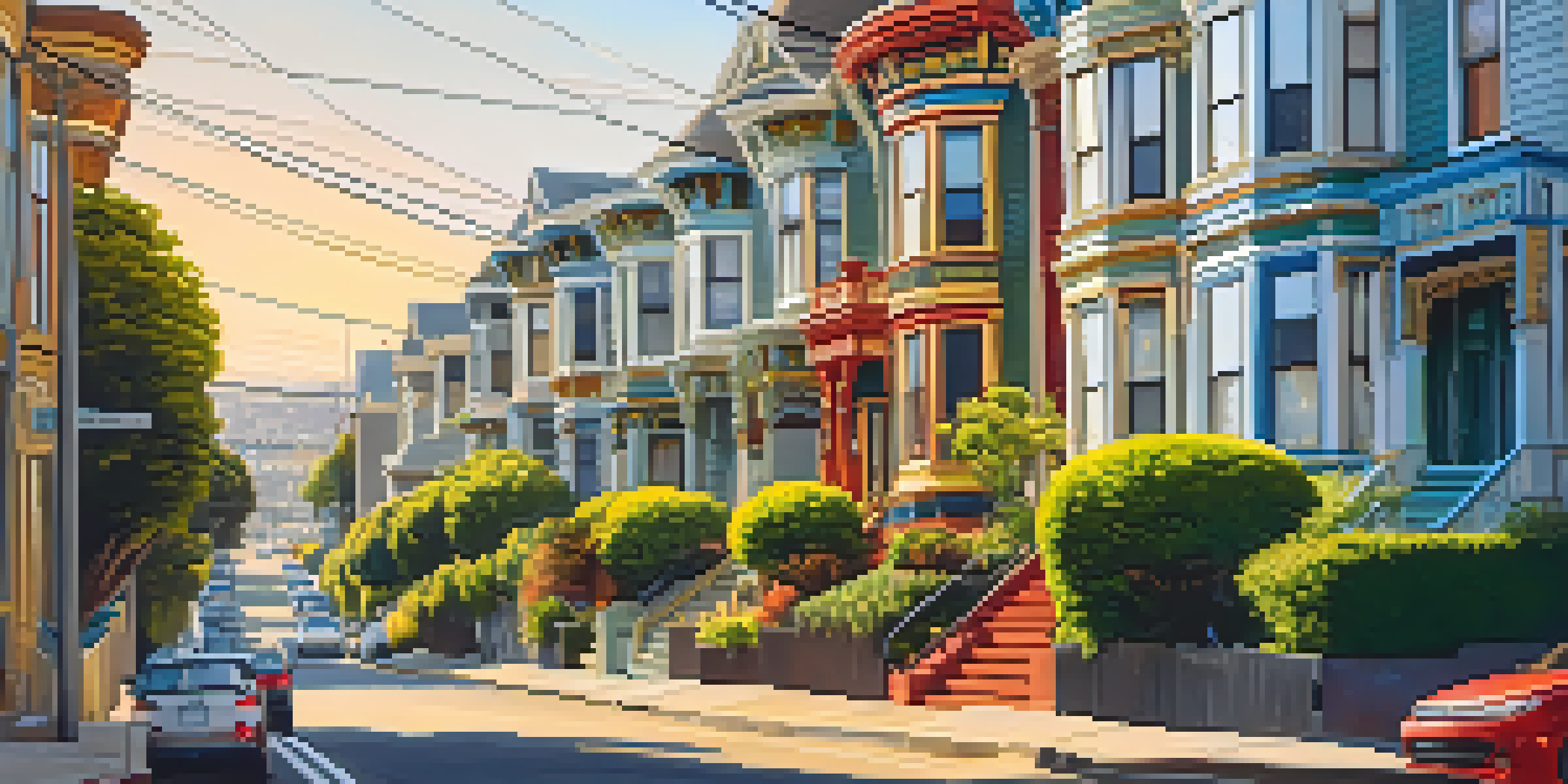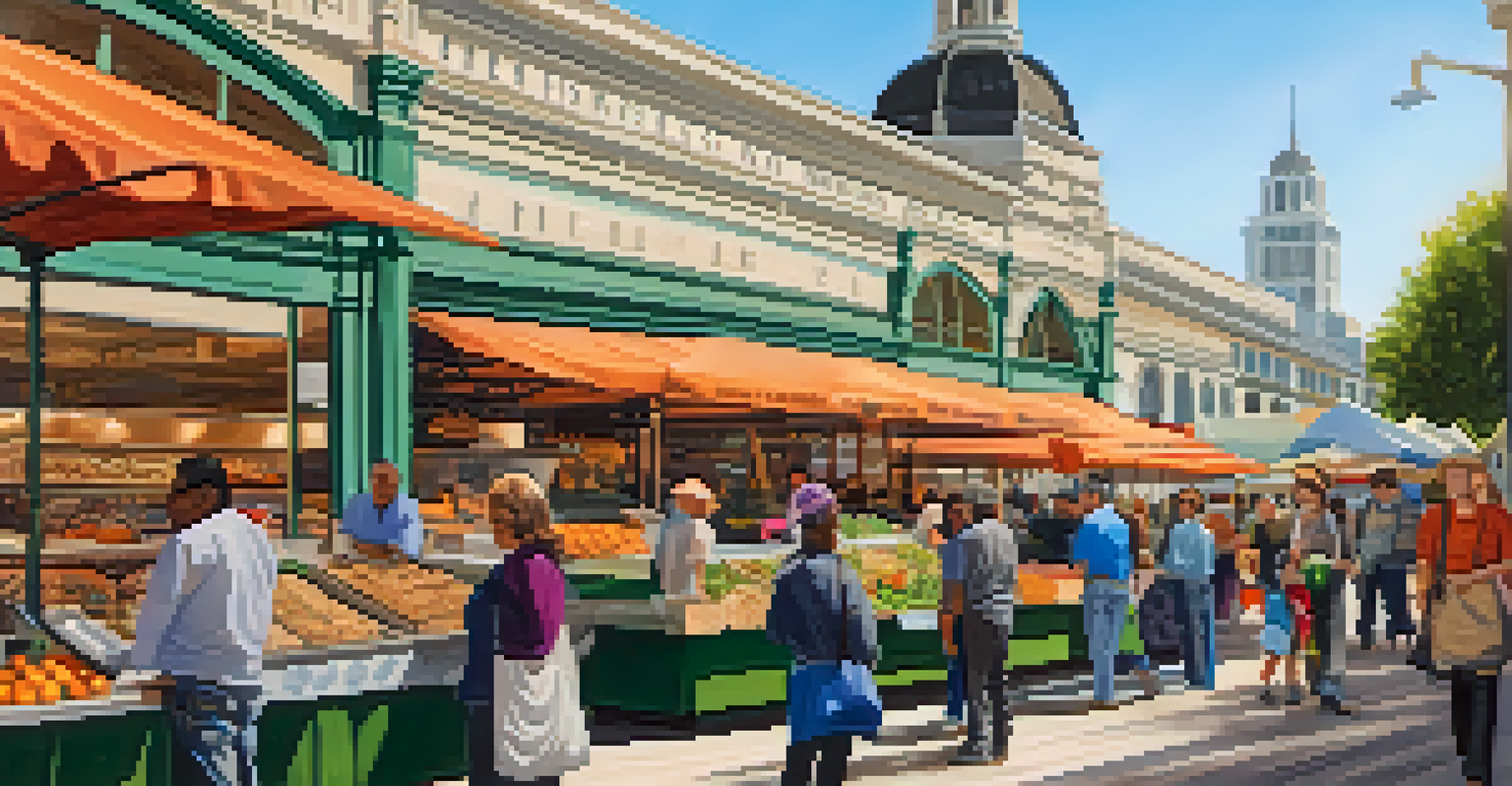Preservation vs. Modernization: A San Francisco Dilemma

The Charm of Historic Preservation in San Francisco
San Francisco is a city steeped in rich history, with its iconic Victorian houses and landmarks like Alcatraz and the Golden Gate Bridge. Preservationists argue that these structures not only tell the story of the city but also contribute to its unique character. Maintaining these historical sites helps foster a sense of identity and belonging among residents, creating a tangible connection to the past.
Preservation is not about the past; it’s about the future. It’s about how we want to live today and tomorrow.
Moreover, preserving history can have economic benefits. Tourists flock to the city to experience its historical architecture, which in turn supports local businesses and creates jobs. For instance, areas like Haight-Ashbury attract visitors drawn to their storied past, thus enhancing the local economy while also honoring the culture of previous generations.
However, the challenge lies in balancing preservation with the need for modernization. As the city grows and evolves, there is a pressing need to adapt structures and spaces for contemporary use, ensuring they remain functional and relevant in today's fast-paced world.
The Push for Modernization Amidst Growth
San Francisco is known for its tech-driven economy and rapid development, which calls for modern infrastructure and housing solutions. Advocates for modernization argue that the city must adapt to meet the needs of its growing population, especially in terms of housing and transportation. With rising rents and a housing shortage, new developments are essential to ensure residents have access to affordable living spaces.

Modernization also brings sustainability into the conversation. New buildings can incorporate eco-friendly designs and technologies, reducing the city’s carbon footprint and contributing to a greener future. For example, energy-efficient buildings not only help the environment but can also save residents money on utility bills.
Balancing Preservation and Growth
San Francisco faces the challenge of preserving its historical charm while accommodating the demands of modernization and a growing population.
Yet, this push for modernity can come at a cost to the city's historical charm. Many fear that new developments could overshadow or even displace the unique character that defines San Francisco, leading to a loss of cultural heritage that cannot be replaced.
Community Voices: The Debate Intensifies
In the heart of this dilemma are the voices of the community, which often present a mix of opinions. Some residents strongly advocate for preservation, arguing that it safeguards their neighborhoods and the stories they hold. Community meetings frequently become battlegrounds where passionate arguments unfold about what should be preserved and what can be changed.
The past informs our future; we can’t lose our historical context in our quest for modernity.
Conversely, there are those who feel that modernization is essential for the city’s survival and growth. They often point to the importance of creating new spaces that cater to diverse populations and promote inclusivity. Their perspective emphasizes that while history is important, so too is the need for a city that evolves and meets the demands of its residents.
This ongoing dialogue reflects a broader trend seen in many urban areas, where the tug-of-war between the past and future creates complex challenges. Finding common ground requires patience, collaboration, and a willingness to listen to various perspectives.
The Role of Local Government in Decision-Making
Local government plays a crucial role in navigating the preservation versus modernization debate. City officials must balance the interests of developers, preservationists, and community members while adhering to zoning laws and building codes. This often results in challenging decisions that can leave some parties dissatisfied, no matter the outcome.
Additionally, government initiatives can support preservation efforts through grants and incentives for maintaining historical buildings. These programs help reduce the financial burden on property owners and encourage them to invest in their properties while maintaining historical integrity. For example, tax credits for restoration projects have proven successful in many cases.
Community Voices Shape the Debate
Residents are deeply divided on the issues of preservation and modernization, with passionate opinions reflecting a broader cultural clash.
However, critics argue that government policies can sometimes favor developers over preservationists, leading to the loss of historically significant sites. This highlights the need for transparent decision-making processes that involve community input to ensure that the voices of all stakeholders are heard.
Case Studies: Successful Balancing Acts
There are several examples in San Francisco where preservation and modernization have successfully coexisted. One notable case is the Ferry Building Marketplace, which was renovated to integrate modern amenities while preserving its historical architecture. This project has become a thriving hub for local food vendors and artisans, drawing in both locals and tourists.
Another example is the transformation of the historic Mission District, where old buildings have been repurposed into vibrant spaces that blend art, culture, and commerce. By respecting the architectural history while introducing modern elements, the community has created a dynamic environment that honors its roots.
These success stories illustrate that with creativity and collaboration, it is possible to find a middle ground. By learning from these cases, other neighborhoods in San Francisco can explore innovative solutions to preserve their heritage while accommodating growth.
Public Sentiment: A City Divided
As San Francisco grapples with this dilemma, public sentiment remains divided. Many residents cherish the city’s historical sites and advocate for their protection, fearing that modernization could erase what makes San Francisco unique. This sentiment is often expressed during discussions about new developments, where passionate pleas for preservation echo through community forums.
On the other hand, there is a significant portion of the population that supports modernization, especially among younger residents and newcomers who seek affordable housing and improved infrastructure. They argue that the city must evolve to meet contemporary needs and that new developments can coexist with historical sites if done thoughtfully.
Local Government's Key Role
The local government must navigate complex interests, balancing the needs of developers, preservationists, and community members to ensure equitable decision-making.
This division reflects a broader cultural clash between valuing tradition and embracing change. As the city continues to grow and evolve, finding a way to unite these differing perspectives will be key to shaping San Francisco’s future.
Looking Ahead: Finding Sustainable Solutions
The future of San Francisco hinges on finding sustainable solutions that honor both preservation and modernization. Community engagement and collaboration will be vital in creating a shared vision that respects the city’s heritage while addressing the realities of modern life. Initiatives that promote open dialogue and compromise can help bridge the gap between differing viewpoints.
Moreover, leveraging technology can play a significant role in this balancing act. Digital tools can facilitate community feedback on proposed developments, allowing for a more inclusive process. By harnessing the power of technology, residents can have a voice in shaping their neighborhoods while preserving their history.

Ultimately, the San Francisco dilemma is not just about buildings; it’s about the people who call the city home. By prioritizing both preservation and modernization, the city can create a vibrant, inclusive, and historically rich environment that reflects the diverse tapestry of its community.